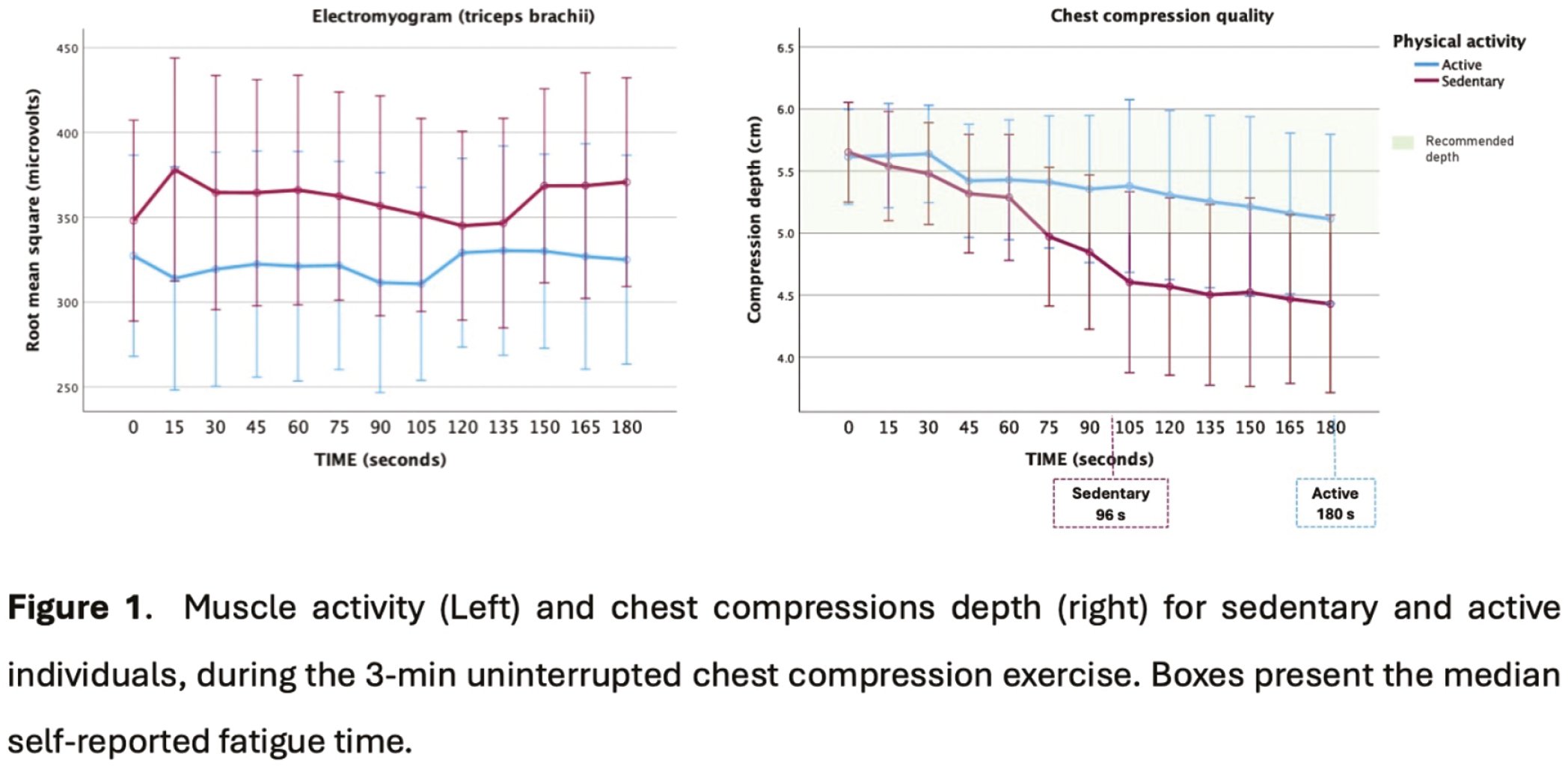
Performing chest compressions (CC) during cardiorespiratory resuscitation (CPR) can lead to rescuer fatigue, potentially diminishing the quality of CPR. Previous studies [1-3] showed that the physical fitness of the rescuer might affect fatigue levels and CPR effectiveness. This study aims to examine how physical activity levels influence muscle activity and its correlation with the quality of CC.
This study is part of an ongoing multicentric pseudo-randomized manikin study, that is being conducted in Portugal, Finland and Germany. Data was collected between May and October 2023. Healthcare professionals (doctors, nurses and paramedics), experienced in CPR, aged between 18 and 65 years-old, were recruited by convenience sample to perform 3 minutes of uninterrupted CC in a Resusci Anne QCPR (Laerdal) simulator, placed on a bed, without mattress. The bed height was adjusted to the rescuer’s knees level.
Socio-demographic data and physical activity levels were collected using a questionnaire, which included the Stanford Brief Activity Survey (SBAS). Electromyogram (EMG) surface electrodes were placed in both triceps brachii to assess the muscle activation levels through the calculation of the root mean square (RMS) value. Participants reported their fatigue timing during the exercise, and perceived exertion was evaluated using the Borg Scale immediately post-trial. CC quality was measured by the depth of compressions recorded by the simulator. EMG and CC depth were sampled every 15-sec and calculated from the mean of 4 consecutive contractions. Approval from the ethical committee was obtained prior the study.
Twenty-five participants were included, with mean age was 38.6 ± 11.4; 60% were female (n=15) and 52% physically active (n=13). During CPR, sedentary individuals reported fatigue earlier than the active participants (96s vs 180s), although not statistically significant. They also experienced a higher perceived exertion after the trial on the Borg Scale (14 vs 12, p = 0,03). EMG showed a slightly greater recruitment of muscle fibres for sedentary individuals, although not significantly different from active participants. (Figure 1-A30, left). Compression depth in sedentary participants decreased over time, with the mean value dropping to sub-optimal level (< 5cm) after 75 s (Figure 1-A30, right).


Physical fitness appears to influence the efficacy of CPR. Active individuals maintained adequate compression depth longer with less muscle activation, suggesting better endurance and technique efficiency. Conversely, sedentary participants experienced quicker fatigue and reduced compression quality, underscoring the importance of physical fitness in performing effective CPR.
Authors confirm that all relevant ethical standards for research conduct and dissemination have been met. The submitting author confirms that relevant ethical approval was granted, if applicable.
1. Nayak VR, Babu A, Unnikrishnan R, Babu AS, Krishna HM. Influence of physical activity of the rescuer on chest compression duration and its effects on hemodynamics and fatigue levels of the rescuer: a simulation-based study. Indian Journal of Critical Care Medicine. 2020.
2. López-González A, Sánchez-López M, Garcia-Hermoso A, López-Tendero J, Rabanales-Sotos J, Martínez-Vizcaíno V. Muscular fitness as a mediator of quality cardiopulmonary resuscitation. American Journal of Emergency Medicine. 2016;34:1845–1849.
3. Ock SM, Kim YM, Chung JH, Kim SH. Influence of physical fitness on the performance of 5-minute continuous chest compression. European Journal of Emergency Medicine. 2011;18(5):251–256.
This work was supported by national funds of the FCT – Fundação para a Ciência e a Tecnologia, I.P., under the project “QualityCPR, ref. 2022.03731.PTDC”, and by a grant from the Laerdal Foundation (ref. 2022-0083).